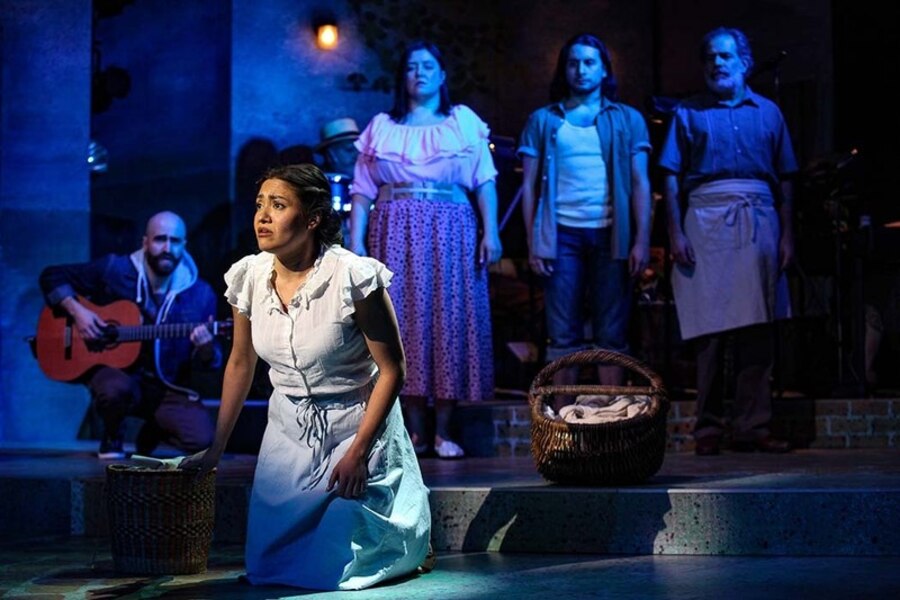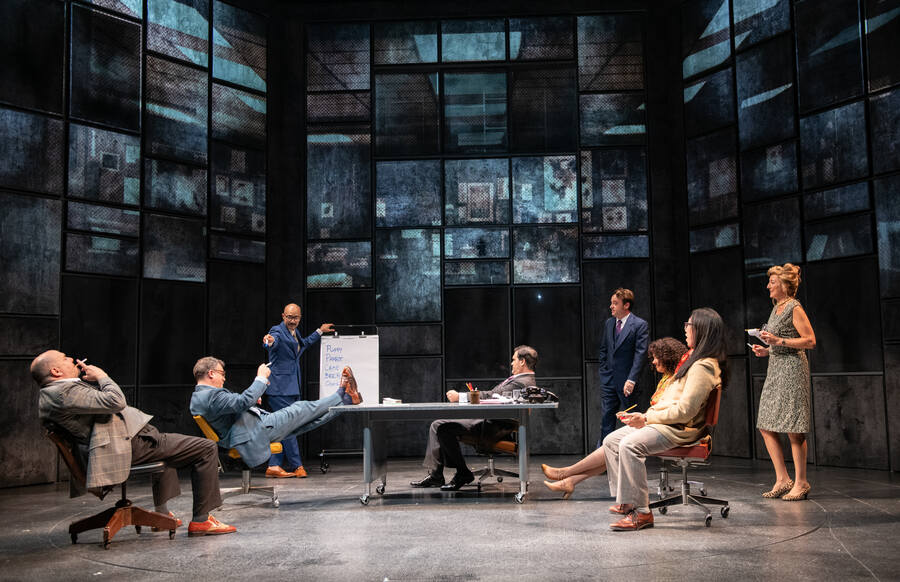In the waning days of the 2022-23 season, I had a realization: Much of what appeared to be thriving onstage where I live in the Washington, D.C., area had been born elsewhere. This was the case for two personal favorites: Aaron Posner and Teller’s magical rendition of Shakespeare’s The Tempest at Round House Theatre in Bethesda, and Joe Murphy and Joe Robinson’s The Jungle, brought to D.C. by Shakespeare Theatre Company and Woolly Mammoth Theatre Company. They and many others came to the area honed by prior runs and made possible by partnerships variously described as “co-productions” or as being presented “in association with.” These are not new designations, but the perceived uptick prompted a question. What do these labels, and the arrangements they denote, really mean? And in a time of renewed financial constraints and struggles to reach pre-pandemic audience levels, are these consolidations one way to thread an increasingly narrow needle?
Shortly thereafter, I began interviewing leaders at eight D.C.-area theatres about their efforts to meet this moment for a piece in the Washington City Paper. Unsurprisingly, co-productions and other partnerships were a common theme. STC’s artistic director, Simon Godwin, went so far as to say that the co-production is a model everyone must grapple with—especially at theatres, like his own, that can no longer produce a full season in-house.
That’s a reality affirmed by Max Schwager, STC’s general manager. Schwager is a significant player in the company’s co-production arrangements, which include three out of its six shows this season: Andrew Lloyd Webber and Tim Rice’s Evita, now running through Oct. 15 and produced in association with the American Repertory Theater; Whitney White’s Macbeth in Stride, opening Oct. 10 after a run at Philadelphia Theatre Company; and Mary Zimmerman’s The Matchbox Magic Flute, arriving in May from the Goodman Theatre. For Schwager, the economics are clear enough. “There is a piece of it that is out of necessity, in this world where theatre staffs have gotten smaller,” he said, pointing to an exodus of workers during the pandemic and the difficulties of replenishing the workforce. “Some of it is that, truly, in order to build the physical show, you need to partner with another theatre.”
In many ways, STC’s approach to co-productions is the norm. While the particulars vary, this model sees partners share the upfront costs of building the production and compensating members of the creative team, such as directors and designers, as well as initial rehearsals at the originating theatre. The second theatre might make a payment in support of that work and pay additional fees for rentals and transportation. Otherwise, from that point on, each keeps to their own: Theatre One compensates actors and crew and pays overhead for their run, Theatre Two receives a more or less fully formed production, and pays its own operational costs. At the end of the day, each keeps its own revenue.
Still, there are variations on the theme, some practical and some largely semantic. STC, for example, lists its shows as produced “in association with,” which for them constitutes a co-production. “In my experience, it’s mostly a point in negotiations about how the two organizations view their collaboration,” said Schwager. For STC, the real, unspoken distinction is in “planned” and “unplanned” co-productions. The former is conceived by the partner theatres and programmed in advance; the latter is a production brought in to fill an empty slot. This was the case last season, when STC brought in Zimmerman’s The Notebook’s of Leonard da Vinci from the Goodman, constituting a co-production “after the fact.”
As Schwager explained, how theatres view and describe their partnerships varies. Round House, for example, draws a distinction between a co-production and their arrangement with Folger Shakespeare Library, who earned an “in collaboration with” credit for The Tempest. According to Round House managing director Ed Zakreski, Folger was keen to keep its subscribers active amid long-running renovations of its space, and effectively traded some support personnel hours and artist housing for a block of tickets set aside for their base.
There is also an important distinction to be made between co-productions and “enhanced” productions. The latter involve commercial partners injecting funds into a nonprofit run, often with an eye to a Broadway move. STC’s recent pre-Broadway mounting of the Britney Spears jukebox musical Once Upon a One More Time, featuring a book by John Hartmere, is a prime example. In addition to supplementary funds, the nonprofit theatres often negotiate a stake in any future commercial run. If my conversations are anything to go by, the details of these arrangements are not for public consumption.

Though schooled in various collaborations and enhancements, Round House has found special success with a more intimate association, specifically with Olney Theatre Center, located in the small town of Olney, Md. The pair closed last season with Bill T. Jones and Jim Lewis’s biographical jukebox musical Fela! at Olney and began this season with James Graham’s ripped-from-the-headlines drama Ink at Round House, which closed early this month due to a COVID-19 outbreak in the production. It’s uncommon for theatres to stage back-to-back co-productions in this manner, but it’s even more remarkable when you consider that Round House and Olney both reside in Montgomery County, which borders Washington, D.C. In a world where most arrangements are made between theatres in different states, even different continents, Round House and Olney are practically next door neighbors.
It’s not the first time the pair have joined forces. In the fall of 2016, they mounted both halves of Tony Kushner’s epic Angels in America in repertory at Round House, with Olney artistic director Jason Loewith helming Part I: Millennium Approaches and his Round House counterpart, Ryan Rilette, handling Part II: Perestroika. The subsequent fall, they staged Lin-Manuel Miranda’s In the Heights at Olney. The partnership grew out of the relationship between Loewith and Rilette, who met during their shared time at the National New Play Network (NNPN), where the “rolling world premiere” program has created a powerful multi-production model all its own. “We knew we had similar ideas about how to build companies and particularly about sharing resources,” said Rilette. “NNPN is very big on finding ways to collaborate together—to not fight each other for a small piece of pie and instead try to build a bigger pie.”
Thanks in part to their proximity, Round House and Olney work together much more closely than typical co-producers. In addition to splitting costs, the theatres share personnel. Olney, for example, has an on-site props department which was able to support Ink at Round House. While attending Fela! in August, I was surprised to discover Maureen McNary, Round House’s patron experience and rentals manager, pitching in on running the house; it was all about showing Round House audiences a familiar face in Olney’s sprawling campus. The companies are so tightly entwined that even Olney’s managing director, Debbie Ellinghaus, is plugged into daily performance and front-of-house reports for Ink—something unheard of in the typically more remote co-production model. The companies are even going so far as to settle up after Ink in order to equitably split the revenue.
For all the obvious benefits, one of the most remarkable results of this partnership is that both theatres have successfully leveraged it to expand their audiences. “We did a study of our audience before and after,” said Round House’s Ed Zakreski, speaking about their prior collaborations on Angels in America and In the Heights. “We were getting people coming to Round House for Angels from areas of the county that had not come before. So that experiment was clearly working.”
He and Ellinghaus point out that the two theatres reside in very different parts of Montgomery County: Round House is right on the D.C. Metro’s red line, Olney a half-hour drive into the country. This quirk of geography means they typically pull from very different parts of Maryland state and the District, so that a co-production theoretically allows each theatre to pull from both.
Of course, even in a fruitful relationship, there are sticky details that need working out. “We had to gain some trust with each other those years, from an administrative standpoint, in terms of how we’re talking to our audience,” said Ellinghaus of the theatres’ initial partnership on Angels in America and In the Heights. Tending to donors, for example, poses challenges when the two theatres have varied public acknowledgments, depending on levels of financial giving. Part of the challenge is ensuring that audiences really register that each company has an equal share in each production. Ellinghaus points to the Washington Post review of Ink, which included only cursory mention of Olney at the very bottom. “So we then have to do a little bit more work as we’re promoting the show to make sure that our audience, the audience that’s receiving emails from the theatre, know why we’re promoting a Round House show,” she said.
Apart from the financial and logistical benefits, co-producers are quick to point out that co-productions allow companies to take on artistic challenges that might otherwise be beyond them. Zakreski credited Round House and Olney’s shared capacity for making their production of Fela! the musical’s first professional outing since its world tour. Despite the allure of spectacle, the costs of production still register for seasoned theatregoers and Round House board members like Mitch Dupler and Linda Ravdin. For Dupler, the sheer size of the cast in such an undertaking was cause for pooling resources. “You can’t budget by aspiration, you have to budget conservatively,” he said. “I think for shows that have big fixed costs, big casts, it really helps to have two theatres bearing those costs.”
Ravdin is active all over the area, and holds subscriptions at Arena Stage, Signature Theatre, and Studio Theatre. While she acknowledged that co-productions have the capacity to capture audiences with something “splashier,” the sight of half-empty houses, particularly at smaller venues staging new works, has been disconcerting.
“What are the economics?” she wondered. “I mean, they have to pay the actor, they have to pay the playwright—the playwright is entitled to make a living—and then the backstage people. I don’t know, I don’t get it.” Dupler echoed this sentiment when discussing the larger crisis in American theatre funding. For him, what is often missing in this conversation is how it all affects the artists.

Thus inspired, I consulted with actor, playwright, and musician Brian Quijada, who is no stranger to multi-production models. His musical Somewhere Over the Border was produced in 2022 by Syracuse Stage, Geva Theatre, and Teatro Vista as part of a rolling world premiere, an arrangement in which several theatres agree to produce the same new play within a certain period but without necessarily committing to cost-sharing between organizations. Quijada’s latest venture, Mexodus, a hip-hop musical co-created with and co-starring Nygel D. Robinson, will be co-produced by Baltimore Center Stage and Mosaic Theater Company in Washington in the coming season. The show is a live-loop musical—Quijada and Robinson will compose brand-new music live, then perform the track while the score plays back in a loop—that tells the story of formerly enslaved people finding new life in Mexico via the Underground Railroad.
For Quijada, the immediate appeal of this fresh co-production is the dual locations. “What I think I love about this co-production is that it’s in two cities that are filled with culture and color,” he said. “They’re both historically Black cities. I’m like, man, they’re gonna hopefully eat up the story.”
The opportunity to enjoy a chain of productions also means more opportunities to fine-tune the show. “It’s almost like treating each run like a preview,” Quijada said. “Once an entire run closes, then you can start teching for the next phase. You can be like, you know what, actually, let’s cut these lines.”
Thinking about the artist’s role in these institutional partnerships, I posed to Quijada a question that had been pestering me: Is there a risk that more co-productions means theatres are simply shifting more of the same work around, rather than opening up opportunities for others? It was an unfair question to pose to someone appearing in two runs of a two-person show—not the kind of spectacles I’ve so far been referencing, Quijada was quick to point out—but he gamely admitted that shipping in productions wholesale could crowd some artists out.
It also, however, cannot help but engage talent in other communities. Besides, said Quijada, the pro side of the argument is that it can keep other jobs thriving. “All these companies can save money, especially with the state of the American theatre right now,” he observed. “You see so many closures of theatres and you’re just like, oh man—please do whatever it takes to stay open.”
For Round House’s Rilette, so much of what co-productions allow for comes down to scale. With that comes, jobs, of course, but also variety. “Collaborating together allows us to be able to still tackle the big, exciting shows without having to only do two-person, three-person, one-person kind of shows, which I think more and more theatres might end up having to go to—and those are fine,” he is quick to add, “but they can become tedious over time. The big projects that are really, really exciting, and when times are tough, that’s hard to do. This is a model under which you can make that happen.”
Jared Strange (he/him) is the director of education and community programs at the National Theatre Foundation, as well as a writer, dramaturg, scholar, and educator based in Washington, D.C.


